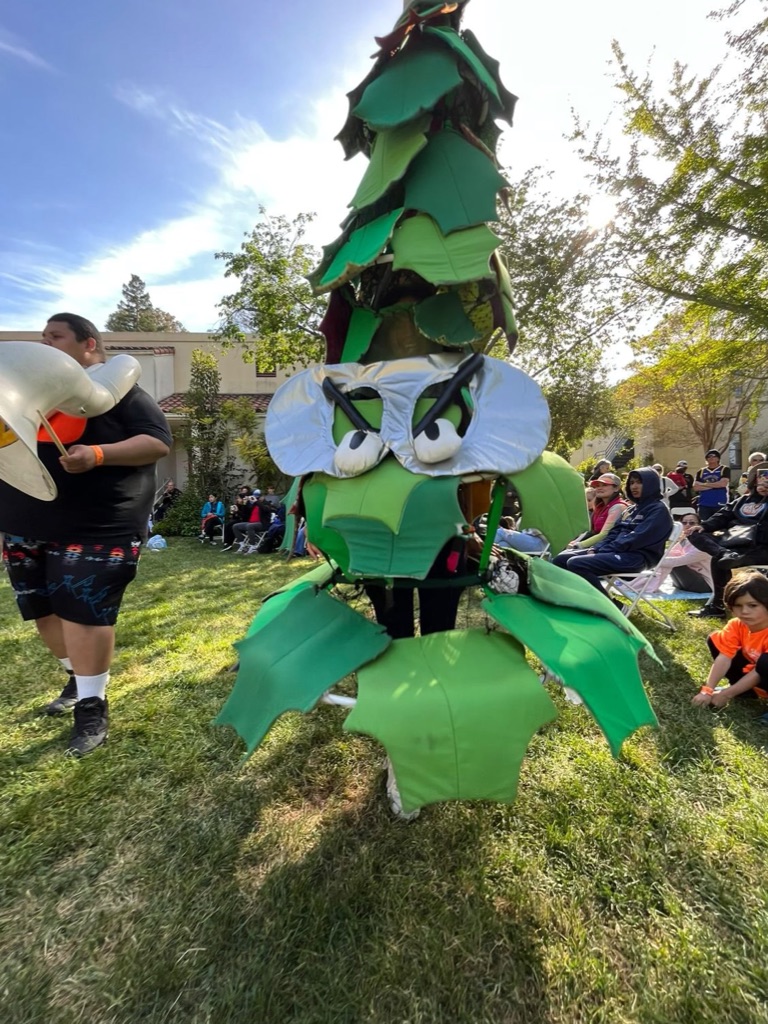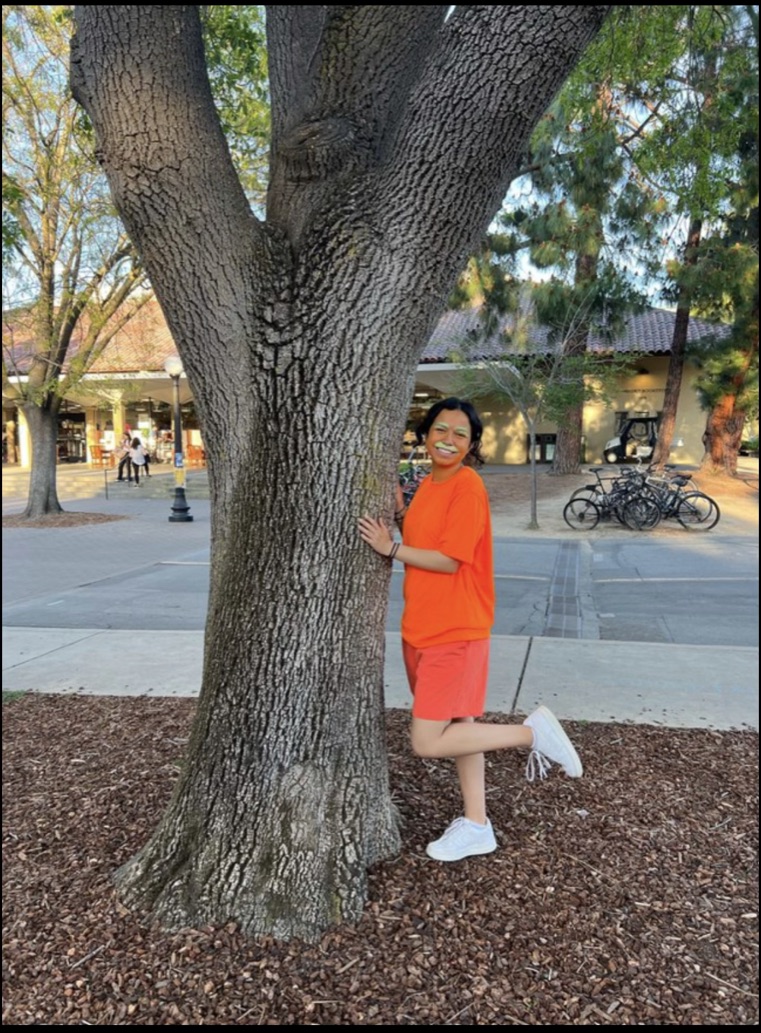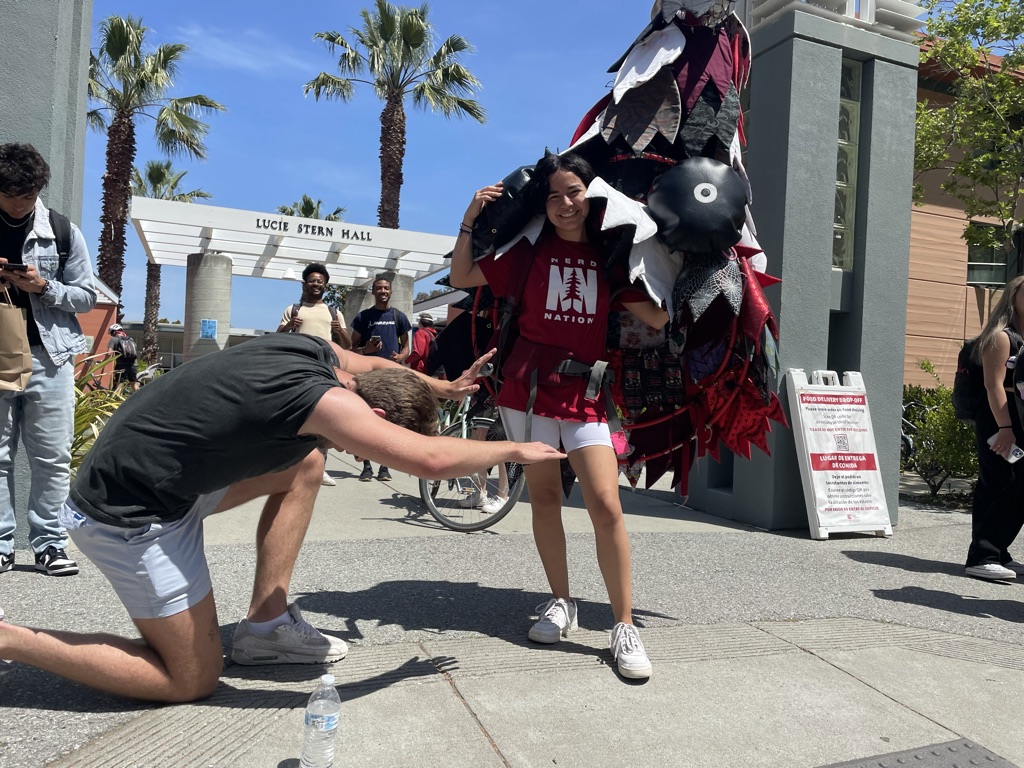Mascots play an indispensable role on any school campus. Beyond entertaining at sporting games, they facilitate dialogue with the student body. Of all mascots, though, one surely stands out for its ability to hype up a crowd with unparalleled spontaneous, funky energy — the Stanford Tree.
Last Saturday, Stanford’s unofficial mascot officially inaugurated its 45th heir: Emily Rodriguez ’26. Her rollout marked the end of Tree Week, a yearly tradition during which prospective “sprouts” vie for the approval of the outgoing Tree with a series of calculated hijinks termed “stunts.”
Each Tree serves a one-year term. Every Spring a new Tree is born, whereupon they are required to entertain at regular rallies and sport events through Fall, Winter and the following Spring. They don the tree costume until it’s time to select their successor.
From the initial group of 14 that attended the information session, three determined sprouts chose to participate in the tryouts this Spring. Rodriguez attributed the dropouts to the large time and energy demands of the position. To her, the singularity of the role makes it worth the sizable commitment.
“Even if that means I’ll probably have to miss out on a couple of things my sophomore year, then so be it, because this is an experience that very few people on this campus will ever get to have,” she said.

Rodriguez had explored a handful of different clubs and activities earlier this year as a freshman, but none of them managed to capture her excitement and dedication in this way. That changed when a friend told her about the Tree audition process. Intrigued by the word “audition,” she inquired further; the rest is history.
Tree Week is anything but a conventional audition. Last year’s Tree, Jordan Zietz ’24, was responsible for judging the sprouts’ stunts. Zietz described searching for a certain enigmatic “energy” — a quality innate to anyone who has borne the beloved suit in generations past.
Stanford’s mascot embodies zaniness in just about every aspect. Its cartoon-like appearance and vibrant, eccentric dancing are the signature companions of the Leland Stanford Junior University Marching Band (LSJUMB). The band itself has even been dubbed the “most banned marching band.”
It comes as no surprise, then, that Tree stunts are an invitation to try almost anything. It is said that there are only three rules: don’t go to jail, don’t go to the hospital and don’t light yourself on fire. According to LSJUMB director Russ Gavin, new safety measures have been implemented in recent years. Sprouts must now sign a conduct agreement, which discourages stunts involving harm, displays of wealth or gratuitous vulgarity.
Rodriguez chose to loosely center her stunts around the theme of “The Lorax.” Her debut stunt was a hatching scene in which she emerged from a cardboard box labeled “Egg” and recited the Dr. Seuss character’s iconic line: “I am the Lorax and I speak for the trees.” She made true on her promise the following day by following Zeitz around and repeating whatever he said. Her favorite stunt involved singing “I Want It That Way” by the Backstreet Boys in the middle of a CS 106B lecture, a class that she was not even enrolled in.

Zietz was most impressed by Rodriguez’s final stunt. In reference to an inside joke with friends from home, Rodriguez swam around an inflatable pool with real cockroaches, ate a few and then proclaimed that she had saved New York City. Ultimately, Zietz said one important factor in selecting her to be his successor was “picking someone who embodies this sentiment of ‘F*ck it we ball.’”
Regarding the inside joke behind the stunt, Rodriguez said, “You’ll just have to be left wondering.”
Zietz believed that a Tree must have a true, deep care for their community. As Tree, “You are the physical embodiment of the spirit of Stanford and the students here,” he said.
The Stanford community welcomed Rodriguez’s new role with a wave of social media congratulations. Rodriguez said she found particularly enthusiastic support from her communities in Casa Zapata and the Central American Student Association (CASA). Being of Nicaraguan descent, she feels proud to be Stanford’s first Central American Tree.
Gavin was likewise gratified by her selection. Recalling Dahkota Brown ’20, who made history as the first Indigenous Tree in 2017, he noted that the Tree has the power to represent different aspects and experiences within the student body.
Rodriguez described herself as an introverted person, despite evidence suggesting the contrary. According to Rodriguez, the crazy Tree persona is simply another side of her personality.
“That’s what this week was for me — just pulling that personality out of myself,” said Rodriguez. “I will have to continue to be that way as long as I am in this tree suit.”
